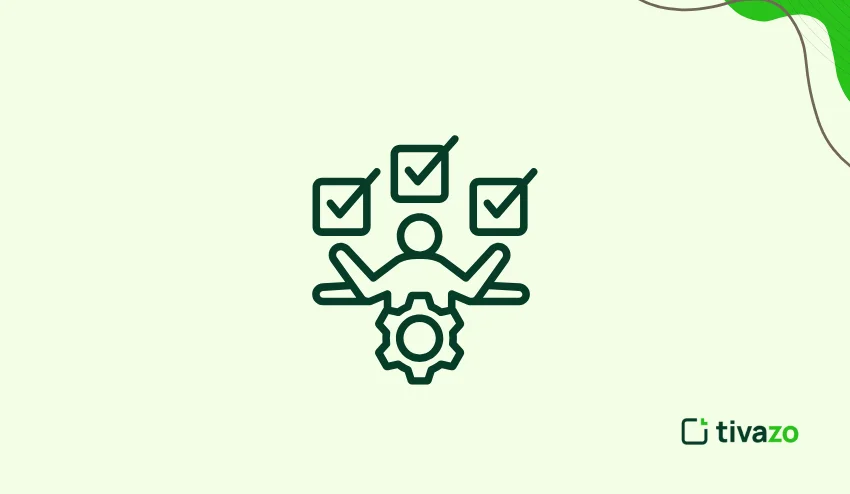Project Productivity determines the outcome of any project; whether the team met its goals to finish on time, stay under budget, and deliver quality, or went through scope creep, missed deadlines, and left people frustrated. In 2026, teams are working in hybrid schedules, barely keeping up with the shifting priorities, working on tighter budgets, and using more tools than they have the capacity for. Clarity, discipline, and the right systems have become non-negotiable.
This guide provides five battle-tested, deeply practical strategies to increase your project productivity, right now, not later. Each strategy offers tactics that can be implemented right away and quick checklists for the practices to incorporate into your workflow, with details of how ‘Tivazo’ fits into each method. Read to the end, and you will walk away with a clear, repeatable plan to out-work and out-deliver anyone still using spreadsheets and guesswork.
Key Highlights:
- What is Project Productivity
- Why Prioritize Project Productivity
- Measuring Project Productivity
- Common Pitfalls That Kill Project Productivity
- Make the Most of Project Management Tools
- Building a High‑Performance Project Team
- How Tivazo Helps Boost Project Productivity
What is Project Productivity?
Project Productivity is the ability of a project team to deliver on project results (efficacy) in the least wasteful way (efficiency). In other words, it is about not simply the output of your team but the outcomes of the work toward the purpose of the project.
Two influences are useful:
- Effectiveness: Did we deliver the outputs that were required? Did it meet stakeholder expectations?
- Efficiency: How much time, money, and re-work was required to get there?
To reach a true sense of project productivity, we need to use both efficiency and efficacy. Just measuring hours or just measuring products disguises the weak spots.
Why Prioritize Project Productivity in 2026?
Focusing on Project Productivity is going to be an increasing emphasis in 2026 because of the changes in the marketplace and the dynamics in teams. This is why it is important:
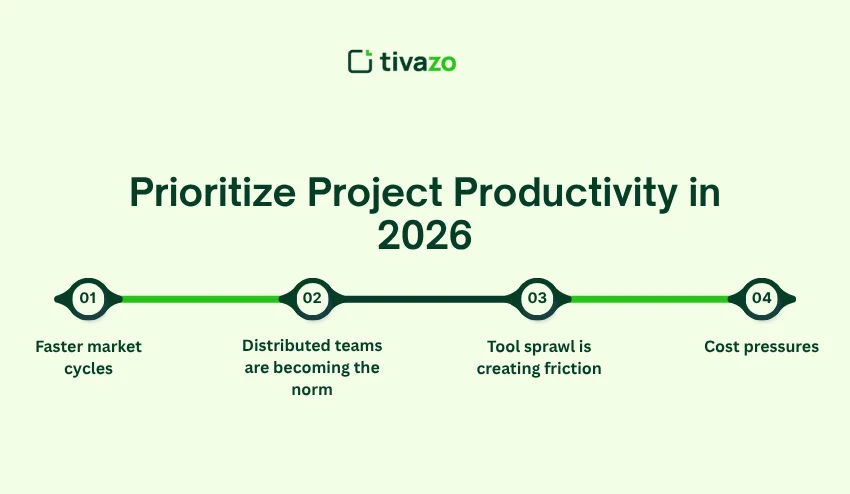
- Faster market cycles: Products and features need to be shipped faster – in the short run, productivity is a competitive advantage.
- Distributed teams are becoming the norm: Remote or hybrid teams need clear systems in which to operate, or they will be in chaos.
- Tool sprawl is creating friction: If we do not have one source of truth about what has and has not been done, work leaks and tasks are slipped.
- Cost pressures: Less waste means higher margins.
Focusing on Project Productivity reduces risks, optimizes stakeholder satisfaction (clients), and allows for time to innovate.
5 Game‑Changing Strategies to Boost Project Productivity
Maximizing productivity in project work will help your team achieve deadlines and project goals. The right approach will help your team overcome issues and remain productive. Here are 5 well-researched strategies to increase project productivity, and thereby success.
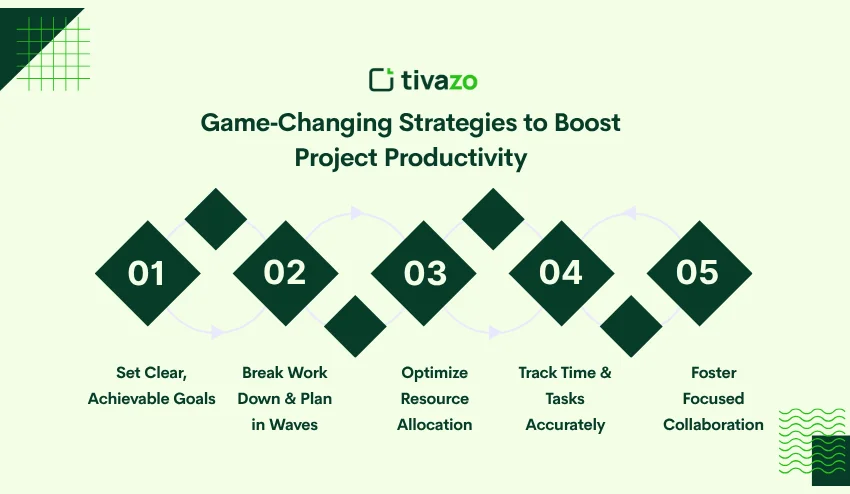
Strategy 1: Set Clear, Achievable Goals (SMART + Outcomes)
Establishing clear, achievable goals is critical for maintaining momentum on projects. When the project goals/standards for success are not clear, the project team can spend many hours figuring out the meaning of “success” for the project and the means to get there. Use a SMART goal (Specific, Measurable, Achievable, Relevant, Time-bound) as the construct to evolve every project objective. Your team will have a clear pathway to success, reducing confusion and ensuring alignment.
- Determine and clarify what success (or failure) looks like for the user/stakeholders.
- Break SMART goals into smaller task-specific goals as action items.
- Ensure that goals are aligned with measurable outcomes and deadlines.
- Revisit and adjust goals often based on circumstances and achievements.
Strategy 2: Break Work Down & Plan in Waves
A large piece of work can be overwhelming and obscure risks. To mitigate this risk, break the work down into small, manageable bits and plan for short, iterative cycles. By planning for short, iterative cycles and a small portion of work, you will quickly understand blockers in the process, and you can simultaneously adapt the plan to get the team back on track while the project is still at a fast pace.
- Plan in small, manageable portions (i.e., two-week sprints).
- Each increment should be validated before advancing to the next phase.
- Review and plan as needed, based on learnings from each increment.
- Continuously check team bandwidth so you can flex the batch size as appropriate.
Strategy 3: Optimize Resource Allocation & Avoid Overbooking
Resource overload is one of the quickest ways to burn out your team and derail project productivity. Through resource allocation, you can ensure your team is functioning within its full potential while not overstretching its limits. Optimizing workloads and giving your team time to focus directly on their work will result in a more efficient output and a more balanced team dynamic.
- Have a visual Team Timeline to account for their availability and workload.
- Allocate resources based on skill sets and current commitments.
- Protect not being pulled into meetings and other distractions while protecting time for heads-down work.
- Regularly account for workload trends to not overload key team members.
Strategy 4: Track Time & Tasks Accurately to Spot Bottlenecks
Keeping precise records of time and task progress is vital for recognizing productivity challenges. When teams are not documenting time regularly, blockers can be unnoticed until the problem is significant. When you document hours spent on tasks and the status of tasks completed, you gain insight into where the inefficiency may exist, and you can adapt in the moment.
- Recording time on tasks allows you to measure total task time and efficiency.
- Monitoring task performance and early identifying blockers.
- Evaluating the task estimate vs time to complete informs of patterns.
- Using previous data on projects to better estimate the time of completion of future projects..
Strategy 5: Foster Focused Collaboration & Rapid Feedback Loops
Collaborating with an effective feedback loop that uses collaboration and feedback communication effectively provides a backbone for striking high-performing teams. Without focused communication and prompt feedback, project teams can drift, and mistakes will be caught too late in the work for action to be taken. While creating focused communication and encouraging speedy feedback can ensure the application of the task and project adapts quickly and unnecessary waste is avoided.
- Discuss matters and provide workspace updates in only one task management system.
- Write task comments using messages, not long email threads.
- Have short regular standups to provide blockers and task updates.
- Create a collaborative culture of feedback and open communication.
Measuring Project Productivity: Metrics That Matter
Measuring project productivity can be tracked by properly recording the following metrics. Any performance metrics give valuable information on the efficiency and success of the execution of your project as it is happening. By monitoring these performance metrics consistently, you can identify areas for improvement, streamline processes, and achieve more efficient outcomes from your team. Here are the six performance metrics you should align:
- Milestone finished on time rate: of course, this is the percentage of milestones you completed by the generally accepted schedule, so this would be a beginning indicator of your project’s timing efficiency overall.
- Estimate accuracy: This metric will assess the actual hours worked versus the hours estimated. In the world of project performance, this will help you understand how accurately you planned your original timing.
- Cycle time: the measure of how much time someone spends working on your task from start to finish.
- Rework rate: percent of tasks that are revised after preview. This metric is an indicator of a quality issue or miscommunication of the original expectations.
- Team utilization: This metric tracks how much of their available time was spent on high-priority project work. To see if your resources are being allocated efficiently or not.
- Client satisfaction/witness rate: This is a qualitative rate you will create to define a metric from your clients’ feedback, indicating how well the project met the client’s expectations.
You can use the metrics data and look for trends that need improvement without punishing one person, but instead as a team continuous improvement.
Common Pitfalls That Kill Project Productivity (and How to Avoid Them)
Many projects experience common traps that can impede productivity. Early identification and resolution of these traps helps you mitigate delays, avoid miscommunications, and limit waste. By identifying challenges you may face and developing plans to avoid them, you can keep your project moving and your team working effectively. Here are some of the more common project productivity traps and ways to avoid them:
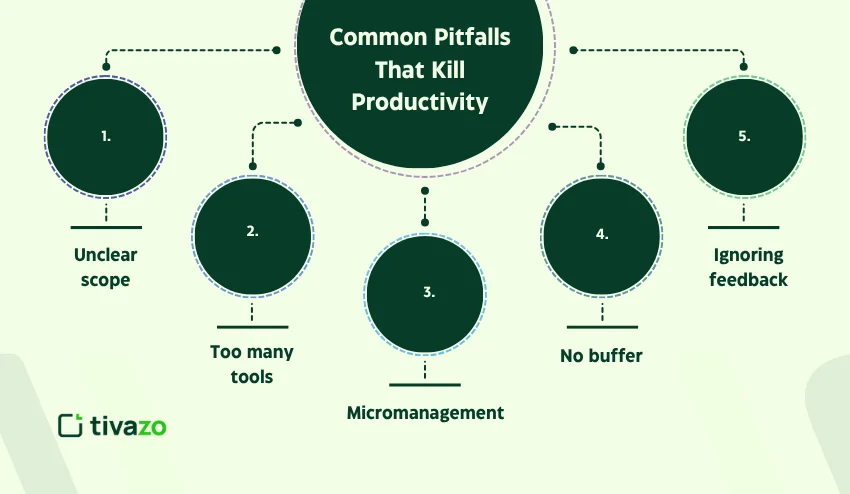
- Unclear scope: Lock your initial scope, objectives, and plan, and create change requests, timelines, and impact evaluation when possible.
- Too many tools: Select one project plan application and one integrated time-tracking application.
- Micromanagement: Define outcomes and review process checkpoints; trust others to create or deliver.
- No buffer: Always assign approx. 10-20% of your original schedule for contingency on critical path activities.
- Ignoring feedback: Consistently gather feedback, prioritize feedback, and take feedback as needed.
How to Make the Most of Project Management Tools in 2026
In 2026, project management tools are changing quickly, with much more intelligent and integrated solutions available. Taking advantage of these capabilities will help to deliver higher efficiency, optimize workflows, and keep projects moving forward. Below are the trends to take advantage of:
Trends to leverage:
- Integrated time + plan – Time tracking can include linking to items in the plan and milestones.
- AI suggestions – Discover overloaded resources with AI suggestions in tasks, and reassign work to keep from exceeding time; AI can also function in determining whether your project is on schedule.
- Real-time dashboards – Stakeholders want a view into the progress of the work; they want to view the timeline and the risk to the project on one screen.
Checklist for tool selection:
- One system-of-record for tasks.
- Easy time capture (timer + manual input).
- Resource availability view.
- Simple reports (estimate vs actual, utilization, bottlenecks).
- Integrations with your messaging and calendar stack.
Building a High‑Performance Project Team
Creating a high-performing project team is about culture and structure, not tools. Establishing roles based on strengths, creating accountability for those roles, and focusing on the elements of continuous improvement creates the framework for high performance. Here’s how to develop a top-performing team:
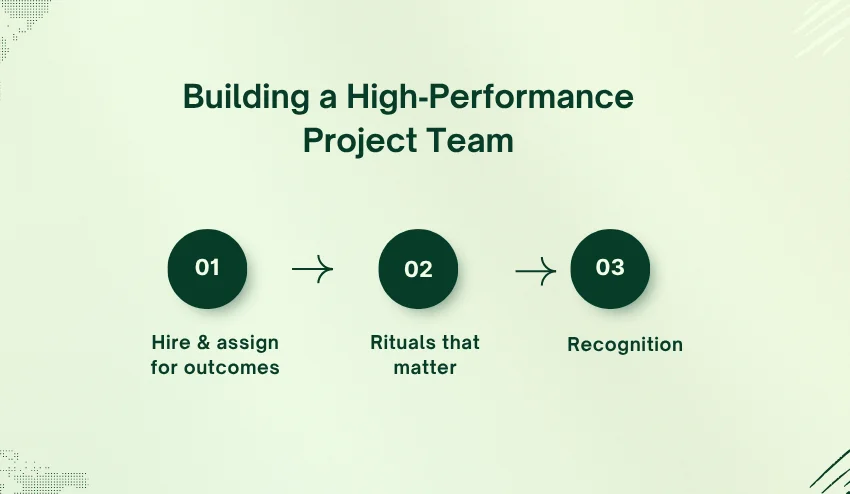
1. Hire & assign for outcomes:
- Assign roles based on strengths/future growth, not convenience.
- Develop a “responsibility owner” for each milestone.
2. Rituals that matter:
- 30-minute weekly learning sessions to discuss what impeded work, and what assisted.
- Monthly retrospective that includes corrective actions.
3. Recognition:
- Celebrate quick wins and strategic pivots, not just the final deliverable.
How Tivazo Helps Boost Project Productivity
Tivazo allows teams to increase productivity by effortlessly tracking time, enhancing transparency, and managing their projects in a proactive, easy-to-use platform. Here are some ways that Tivazo supports your project success.
- Effortless Time Tracking
Tivazo’s easy-to-use timer means any member of the team can track their hours, with ease and accuracy, either automatically or manually. This level of accuracy feeds into the project log to keep a project on track and ensures every minute worked is tracked! - Real-Time Activity Monitoring
As work is happening, managers will obtain real-time insights regarding how the work is proceeding through live snapshots of the activity. Attempting to keep teams responsible without disrupting workflows or privacy is key for being effective. - Instant Idle Alerts
In addition to tracking the time spent on meetings or tasks, Tivazo provides you with insights into your resource utilization and workload balance, making planning and billing for your projects a whole lot easier. - Complete Work Transparency
By recording time spent on meetings and tasks, Tivazo offers insights into resource use and workload balance, making project planning and billing more precise. - Scalable and Secure
Tivazo is designed for freelancers and teams of any size with various customized settings and security to keep your project data secure while being flexible to your team’s needs.
One of the key features of Tivazo is it helps to keep teams aligned, accountable, and efficient so that projects can progress smoothly and on time.
Quick Implementation Plan: Start This Week
In order to ensure a smooth, consistent, and effective start, it is important to use a structured approach to implement the strategies. This may seem overwhelming so by breaking it down into the steps below will make it easier to implement, create and follow the plan, track progress and identify opportunities for improvement. Here is a quick implementation plan for you to utilize this week to get your project on track:
Day 1: Create project outcome + 3 milestones. Assign owners
Day 2: Populate the Team Timeline and mark availability
Day 3: Break the work down to ≤10 tasks per milestone and estimate hours
Day 4: Start timers on core tasks and collect one week of real data
Day 5: Run the 1st Sprint Review, check the estimate vs actual and re-assign 2 tasks based on the data.
Resources & Templates (copy these into your workspace)
To manage your project and make implementation easier, we have compiled several important resources and templates for you to implement directly into your workspace to remain managed and track progress for your team to collaborate effectively on:
- SMART goal template (one line outcome + 3 milestones)
- Sprint task decomposition checklist
- Team Timeline template (availability + booked %)
- Estimate vs Actual quick report (spreadsheet or Tivazo dashboard)
Conclusion: Win the Project Productivity War in 2026
Project Productivity is not a buzzword, its a disciplined process. The five strategies listed above create structure, not hope – clear outcomes, small validated delivery, smart resource allocation, accurate tracking, and focused collaboration. Together with consistent use of the right tools and relentless measuring of productivity, you are now creating a competitive advantage in project productivity for your team.
Take one step today: Choose one active project, and implement the Day 1 – Day 5 plan from above. Use Tivazo to gain time and visibility. Choose one clear metric to track this month (either milestone on-time rate, or estimate accuracy). Small wins, consistency, and time compound, and in no time, your team will be the one everyone else uses as a benchmark.
Call to action: Ready to experiment with these strategies on a live project? Take us up on Tivazo’s free trial, design your first Team Timeline, and implement the 5-day plan. Then come back here and tell me which metric moved you first – and we’ll iterate the plan to leverage that faster.

